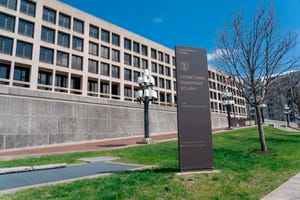USDA begins review of poultry slaughter line rule
Chicken industry hopeful three decades of work will prevail in helping improve food safety efforts.

As part of its regulatory freeze to evaluate the previous administration’s action, the Biden administration issued a temporary freeze on a rule dictating allowable poultry slaughter line speed increases. The rule in question allows establishments to increase line speeds from 140 birds per minute up to 175 bpm.
A spokesman for USDA’s Food Safety and Inspection Service confirmed the line speed rule is one of several rules and regulations that fall under the regulatory freeze memo issued last week by the White House. The memo requests all federal agencies “withdraw any rules that were submitted to [the Office of Information and Regulatory Affairs] OIRA prior to January 20, 2021.” As directed, USDA withdrew this rule pending an ongoing review.
“This action by the administration is a standard process that every incoming administration does – issue a temporary regulatory freeze to assess all rulemakings currently under way, review them in light of administration priorities, and then decide whether to move forward. We are hopeful that it will move forward,” says Ashley Peterson, National Chicken Council's senior vice president of scientific and regulatory affairs.
“In this case, FSIS will have plenty of data from decades of experience that show establishments can operate at lines speeds of up to 175 birds per minute while maintaining exceptional food and worker safety standards,” notes Sarah Little, spokesperson for the North American Meat Institute.
During the Obama Administration, then Secretary of Agriculture Tom Vilsack oversaw the finalization of the rule in 2014 and touted the New Poultry Inspection System as a way to improve food safety and better position food safety inspectors throughout poultry facilities. The Trump administration took additional action on the rule in 2018.
In August 2014, FSIS established the NPIS as an additional inspection system for young chicken and all turkey slaughter establishments. In poultry inspection systems other than the NPIS, online inspectors are positioned along the slaughter line and are responsible for identifying unacceptable carcasses and parts, examining carcasses for visual defects and directing establishment employees to take appropriate corrective actions if carcass defects can be corrected through trimming and processing. In 2018, USDA created a waiver system allowing slaughterhouses to petition to run at the higher rates if they follow specific protocols.
The maximum line speed authorized under these inspection systems reflects the time it takes for an inspector to effectively perform the online inspection procedures required for the system. The fastest line speed authorized for a non-NPIS young chicken inspection system is 140 bpm, which requires 4 online inspectors with each inspecting 35 bpm. The NPIS system enables more efficient inspection and faster line speeds in many establishments.
Peterson adds, “It would be unfortunate for the new administration to ignore three decades of science, data and court decisions, in a move that would hamstring the U.S. poultry industry on a global scale. This might have been the most deliberative and studied rule that has ever been proposed.”
Line speeds of up to 175 bpm have been utilized in the U.S industry for more than two decades, put forward by the Clinton administration, Peterson says. “The modernized system has been studied, debated and reviewed in depth for 25 years to assure its effectiveness in further modernizing chicken inspection while improving food safety and protecting workers.”
Poultry processing rule reviewed
While the poultry industry has been safely increasing line speeds over the past 25 years, Peterson says the injury and illness rate has fallen 86% and is now at an all-time low, according to the most recent data from the Department of Labor. “In fact, it is now lower than the ‘all-manufacturing’ category for the first time ever. The line speeds in question deal with a part of the plant (evisceration) that is almost entirely automated today,” she says.
New scientific data also shows that higher line speeds in young chicken slaughter establishments do not predict increased Salmonella contamination risks.
In February 2020, Humane Society of the United States, Animal Outlook, Mercy for Animals, Government Accountability Project and Marin Humane, filed a lawsuit challenging the process USDA used in creating its line speed waiver system. They welcomed the action taken by the Biden administration.
“Allowing the USDA to ratchet up line speeds would have been an animal welfare and worker safety nightmare,” says Sara Amundson, president of the Humane Society Legislative Fund. “Both the Occupational Safety and Health Administration and the Centers for Disease Control have suggested that line speeds be decreased to allow slaughter facilities to implement stronger social-distancing protocols. Allowing this rule would have demonstrated a staggering lack of judgment and recklessness under the circumstances.
“We will continue to work with the Biden Administration to make sure additional steps are taken to slow down line speeds across the industry to protect animal welfare and worker safety,” Amundson continues.
Kitty Block, HSUS president and CEO, says this was a “priority ask for us with the presidential transition team.” Block adds it sends a “clear message to the meat industry, the agency’s new leadership and the American public.”
Food & Water Watch Executive Director Wenonah Hauter adds, “This is just the first of many steps the USDA must pursue to demonstrate a long-term commitment to prioritizing public health and safety over corporate profits. Given Secretary Tom Vilsack’s record, we must be diligent and aggressive in holding this administration accountable - on everything from future line-speed decisions to the foolish trend of turning over federal inspection of meat and poultry plants to companies themselves. Allowing profit-driven corporations to inspect their own operations would be a gross dereliction of duty by the USDA.”
About the Author(s)
You May Also Like





